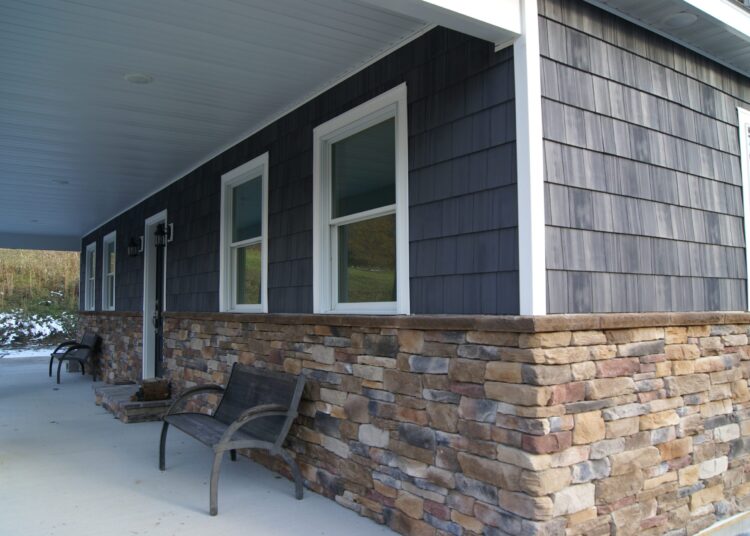Embark on a journey to explore the world of house exterior vinyl siding, where style meets durability and functionality. Discover the endless possibilities and benefits of this versatile material that can transform the look of your home.
Learn about the different styles, colors, and textures available, and how vinyl siding can be a game-changer for your property.
Introduction to Vinyl Siding
Vinyl siding is a popular choice for house exteriors due to its durability, low maintenance, and aesthetic appeal. It is a type of plastic exterior cladding that is designed to protect the underlying structure of a building from the elements.Benefits of Vinyl Siding
- Low Maintenance: Vinyl siding requires minimal upkeep compared to other materials like wood or brick. It does not need to be painted and can be easily cleaned with soap and water.
- Durability: Vinyl siding is resistant to rot, moisture, and insects, making it a long-lasting option for homeowners.
- Affordability: Vinyl siding is a cost-effective alternative to materials like wood or stucco, making it a budget-friendly choice for many homeowners.
Styles, Colors, and Textures
Vinyl siding comes in a variety of styles, colors, and textures to suit different architectural preferences and design aesthetics. Some common options include:- Traditional Lap: Mimics the look of wood siding with horizontal panels.
- Vertical Panels: Offers a modern, sleek appearance with vertical siding panels.
- Shake/Shingle: Resembles the texture of cedar shakes or shingles for a rustic charm.
- Smooth or Wood Grain Finish: Provides a smooth or textured finish to replicate the look of real wood.
Installation Process
Installing vinyl siding on a house exterior involves several key steps to ensure a successful outcome. Proper insulation and waterproofing are crucial aspects of the installation process to protect the home from elements and maintain energy efficiency.Preparation and Planning
Before starting the installation, it is essential to prepare the exterior of the house by removing any existing siding, repairing damaged areas, and ensuring a smooth, clean surface. Proper planning includes measuring the walls accurately and ordering the right amount of siding and materials.Tools and Materials
- Vinyl siding panels
- J-channel
- Utility knife
- Tin snips
- Level
- Tape measure
- Nails or screws
- Caulk
- House wrap
Installation Steps
- Begin by installing house wrap or insulation board to provide a moisture barrier and improve energy efficiency.
- Install J-channel around doors, windows, and corners to receive the ends of the siding panels.
- Start at the bottom of the wall and work your way up, overlapping the panels to prevent water infiltration.
- Cut the siding panels to fit using a utility knife or tin snips, making sure to leave room for expansion and contraction.
- Secure the panels to the wall using nails or screws, ensuring they are level and properly aligned.
- Finish the installation by adding trim pieces, such as corner posts and window casings, to complete the look and provide a polished finish.
Importance of Insulation and Waterproofing
Proper insulation and waterproofing are essential during vinyl siding installation to prevent moisture buildup, mold growth, and energy loss. Insulation helps regulate temperature and reduce energy costs, while waterproofing protects the structure from water damage and extends the lifespan of the siding.Maintenance and Care
Proper maintenance is essential to prolong the lifespan of your vinyl siding and keep it looking its best. By following a few simple tips, you can ensure that your siding remains in top condition for years to come.Cleaning and Maintenance
Regular cleaning is key to maintaining vinyl siding. Use a mixture of water and mild soap to scrub away dirt and grime. Avoid using harsh chemicals or abrasive tools that could damage the surface of the siding.- Wash your vinyl siding at least once a year with a garden hose or pressure washer to remove built-up dirt and debris.
- Inspect the siding for any signs of mold or mildew growth, especially in damp or shaded areas. Use a solution of water and bleach to clean affected areas.
- Trim any trees or bushes near the siding to prevent scratches or damage from branches rubbing against the surface.
Common Issues and Solutions
Vinyl siding can sometimes experience issues like fading, cracking, or warping. Knowing how to address these problems promptly can help prevent further damage and maintain the appearance of your home.- Fading:Over time, vinyl siding may fade due to exposure to sunlight. Consider applying a UV-resistant coating to protect the color and prevent fading.
- Cracking:Inspect the siding for any cracks or breaks. Replace damaged sections to maintain the integrity of the siding and prevent water infiltration.
- Warping:Warped siding can be caused by extreme temperatures or improper installation. Consult a professional to repair or replace warped sections for a seamless look.
Repairing Damaged Sections
If you notice any damaged sections of vinyl siding, it's important to address them promptly to prevent further issues. Follow these best practices for repairing damaged sections effectively.- Cut out the damaged portion of the siding using a utility knife.
- Measure and cut a replacement piece of siding to fit the area precisely.
- Slide the new piece into place and secure it with nails or screws, ensuring it blends seamlessly with the existing siding.
Durability and Weather Resistance
Vinyl siding is known for its exceptional durability and weather resistance, making it a popular choice for homeowners looking for a low-maintenance siding option.Durability Against Various Weather Conditions
Vinyl siding is designed to withstand a wide range of weather conditions, from intense heat to freezing cold temperatures. It does not warp, rot, or corrode like other materials, making it an ideal choice for regions with extreme climates.Resilience Against Elements
- Vinyl siding is highly resistant to wind, capable of withstanding strong gusts without damage.
- It is also waterproof, protecting your home from rain and moisture infiltration.
- UV exposure is not a concern with vinyl siding, as it is designed to resist fading and discoloration over time.
Longevity Compared to Other Siding Materials
When compared to other popular siding materials like wood or aluminum, vinyl siding has a longer lifespan. It requires minimal maintenance and does not need to be repainted, saving homeowners time and money in the long run. Additionally, vinyl siding is less prone to damage from pests and insects, further adding to its longevity.Cost Considerations
When considering vinyl siding for your house exterior, it is important to break down the cost factors involved to make an informed decision. Vinyl siding is known for being a cost-effective option, but there are various aspects to consider when evaluating the overall cost.Upfront Costs vs Long-Term Savings
- Upfront Costs: The initial cost of purchasing and installing vinyl siding can vary depending on factors such as the size of your home, the quality of the siding, and any additional features or customization. However, vinyl siding is generally more affordable compared to other materials like wood, fiber cement, or brick.
- Long-Term Savings: While the upfront cost of vinyl siding may be lower than other alternatives, it is essential to consider the long-term savings that come with choosing vinyl. Vinyl siding requires minimal maintenance and is durable, which can save you money on repairs and replacements over time.
Comparison to Other Materials
- Wood: Wood siding can be more expensive upfront and requires regular maintenance, such as painting or staining, which can add to the overall cost over time.
- Fiber Cement: Fiber cement siding is durable and low maintenance, but it can be more costly to install compared to vinyl siding.
- Brick: Brick siding is known for its longevity and classic look, but it is one of the most expensive options upfront and can be labor-intensive to install.









